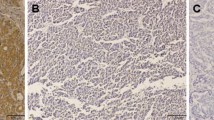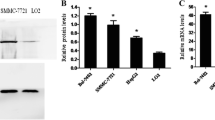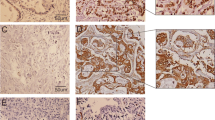Summary
To explore the relationship of angiogenesis-related angiopoietin-2 gene and its receptor Tie2 with angiogenesis and the biology, of hepatocellular carcinoma (HOC), angiopoietin-2 gene, Tie2 and CD34 protein expression in 22 resected HOC, 8 cirrhotic and 8 control liver specimens were investigated byin situ hybridization and immunohistochemistry respectively, and the level of angiopoietin-2 and Tie2 expression in HCC were compared in terms of tumor biological parameters. It was found that CD34 was not expressed in control liver, expressed scarcely in cirrhotic liver (17. 8±13.5/HP), but intensively expressed in HCC (86. 3±34. 8/HP,P<0.01). Tie2 receptor was not expressed in controls, expressed at low level in cirrhotic liver (11. 3±8.7/HP), while strongly positive in the microvascular endothelia of HCC (52. 4±16. 7/HP,P<0.01). The level of Tie2 receptor expression in HCC was closely related with tumor diameter, angiogenesis and portal invasion. Angiopoietin-2 gene was not expressed in control liver, expressed mildly in cirrhotic liver (11.2±9. 7/HP), but extensively in tumor zone (36. 4±17. 5/HP), the level of angiopoietin-2 expression was closely related with angiogenesis, portal invasion and histological grading of HCC. It is concluded that angiogenesis is increased in HCC; angiopoietin-2/Tie2 expression in human hepatic carcinoma is closely related with angiogenesis, which are probably involved in the HCC angiogenesis regulation, promoting the development and metastasis of human hepatic cancer.
Similar content being viewed by others
References
Folkman J. Tumor angiogenesis: therapeutic implication. New England J Med, 1971,285:1182
Torimura T, Sata M, Ueno Tet al. Increased expression of vascular endothelial growth factor is associated with tumor progression in hepatocellular carcinoma. Human Pathol, 1998,29:986
Santo T, Yozawa Y, Deutsch Uet al. Distinct roles of the tyrosine kinase receptors Tie-1 and Tie-2 in blood vessel formation. Nature, 1995,376:70
Peters K G, Coogan A, Berry Det al. Expression of Tie2/Tek in breast tumor vasculature provides a new marker for evaluation of tumor angiogenesis. Br J Cancer, 1998,77:51
Siemeister G, Schirner M, Weindel Ket al. Two independent mechanisms essential for tumor angiogenesis: Inhibition of human melonoma xenograft growth by interfering with either the vascular endothelial growth fac(Continuted from page 230) tor receptor pathway or the Tie2 pathway. Cancer Res, 1999,59:3185
Davis S, Aldrich T H, Jones P Fet al. Isolation of angiopoietin-1, a ligand for the TIE2 receptor, by secretion-trap expression cloning. Cell, 1996,87:1161
Maisonpierre P C, Suri C, Jones P Fet al. Angiopoietin-2, a natiral antagonist for Tie2 that disruptsin vivo angiogenesis. Science, 1997,277:55
Stratmann A, Risau W, Plate K H. Cell type-specific expression of angiopoietin-1 and angiopoietin-2 suggests a role in glioblastoma angiogenesis. Am J Pathol, 1998, 153:1459
Tanaka S, Mori M, Sakamoto Yet al. Biologic significance of angiopoietin-2 expression in human hepatocellular carcinoma. J Clin Invest, 1999,103:341
Lin P, Buxton J A, Acheson Aet al. Antiangiogeneic gene therapy targeting the endothelium-specific receptor tyrosine kinase Tie2. Proc Natl Acad Sci USA, 1998, 95:8829
Takahama M, Tsutsumi M, Tsujiuchi Tet al. Enhanced expression of Tie2, its ligand Angiopoietin-1, vascular endothelial growth factor, and CD31 in human non-small cell lung cancer. Clin Cancer Res, 1999, 5:2506
Holash J, Maisonpierre P C, Compton Det al. Vessel Cooption, Regression, and Growth in Tumors Mediated by Angiopoietins and VEGF. Science, 1999,284:1994
Author information
Authors and Affiliations
Rights and permissions
About this article
Cite this article
Libo, C., Zhen, Y., Guobin, W. et al. Expression of angiopoietin-2 gene and its receptor Tie2 in hepatocellular carcinoma. Current Medical Science 21, 228–230 (2001). https://doi.org/10.1007/BF02886437
Received:
Published:
Issue Date:
DOI: https://doi.org/10.1007/BF02886437




